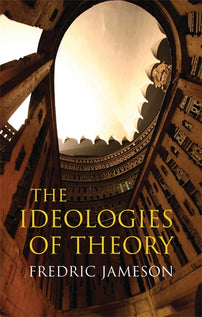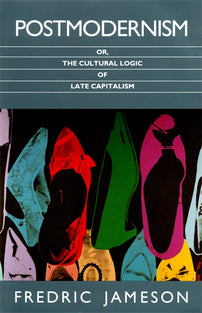On Prophetic Form and the Whole Tangled, Dripping Mass of the Dialectic: Jameson at 90
In celebration of Fredric Jameson's 90th birthday, Christopher Breu explores Jameson's work as theorist of temporality and futurity in his 1971 book, Marxism and Form.

There is a chart three quarters of the way through the epochal 110-page final chapter of Marxism and Form, “Toward a Dialectical Criticism,’ that transfixed me when I first read it. My initial reading of this chart took place while I was sitting in that venerable Santa Cruz institution Zachary’s, waiting for my friend Valerie to show up for breakfast. I remember reading the chart and my mind just racing. It hit me with the force of a modernist epiphany, the kind to which us postmodern, theory-minded graduate students in the 1990s, with our investments in playful irony and pastiche, were supposed to be immune. Not yet a Greimasian square (that would not come till The Prison House of Language and grow, seemingly, ever more complex with each subsequent book), the chart is a simple four term diagram, working through the different permutations set up by the two pairs, positive and negative and passive reflection and active resolution. Indeed, the chart has been so important to my thinking that the page it is on is the only one that is fully detached in my decades old copy of Marxism and Form, although the whole book is decorated with a palimpsest of notes.
It was the bottom right corner of the chart that mesmerized me. In that corner, at the intersection of positive and active was the simple phrase “open or prophetic form” (389). While I had grown up reading science fiction, I had forgotten about literature’s relationship to possible futures. The idea of literature as prophetic, suddenly, opened a whole new dynamic world of what literature and culture, understood dialectically, could imagine and help enact. In our own moment of climate emergency and profound global inequality, such a prophetic dimension in literature and culture—such an imagining of new cultural forms and practices—is precisely what we need.
I had spent my undergrad years in what at that time was a very traditional English program at Northwestern, which I chafed against. I came to Santa Cruz, a place at which Fredric Jameson taught and helped shape, to learn theory and the cutting edge of literary analysis. Indeed, Santa Cruz was not only shaped by Jameson but by the students of Jameson, who were my teachers, including José David Saldívar (who first taught me Marx and Hegel and encouraged me to read “Toward a Dialectical Criticism”), Carla Freccero, Kristin Ross, and Richard Terdiman. (I owe them all so much.) Jameson’s thought pervaded the institution.
[book-strip index="1"]
I very much wanted to learn theory, the term buzzing and half-whispered even in the hallways of Northwestern, yet much of poststructuralism (especially deconstruction) left me flat. I didn’t want to obsess, in microscopic ways, over texts (as much as I loved close reading). Jameson, however provided an understanding of how literature, very much including the traditional canon I learned at Northwestern as well as all the popular culture I was learning to take seriously, could open outwards, and inwards, to the world (or the “concrete” as Jameson regularly puts it in Marxism and Form). And the worldliness of literature wasn’t found primarily in its content (which, as he argues, is not materiality but “content” or the already preformed stuff of language) but in its form.
We tend to think of Jameson as a theorist of the relationship of literary form to space and history (and given the powerful thesis of the Postmodernism book, the two are often imagined in opposition to each other). Yet the theorist who emerges most forcefully from Marxism and Form is one of temporality and futurity. Of course, history is a way of periodizing (and thus spatializing) temporality; futurity always exists in relationship to various imagined and real pasts and infuses the flickering apprehensions of a present. Moreover, Jameson clearly theorizes both time and futurity at various moments in his work (one only has to think of the Seeds of Time and Archaeologies of the Future respectively), but Marxism and Form, at least for me, was the book where I could see something like the whole of Jameson’s theoretical framework become manifest. Indeed, you can see, in embryonic form, the presence of much of Jameson’s future works in the early book, including the discussion of a new form of post-war consumer culture that would provide seeds for Postmodernism, the tantalizingly brief engagement with Marcuse and Bloch on social desire, which would find a must grander expression in The Political Unconscious, and the engagement with Lukács on reification, from which a hundred essays would spring, most famously “Reification and Utopia in Mass Culture.”
In mentioning these germinal moments, I am not suggesting that Jameson’s rehashes the same insights or arguments in different texts. Such an approach is fundamentally a misunderstanding of his scholarly practice. His work, like the dialectic, is constantly in motion, always opening into a transformed engagement with specific questions in a new material, historical, and existential situation. It is not that his work repeats itself (although there is much virtue and difference in ostensible repetition as everyone from psychoanalysis to Deleuze and Derrida has taught us). It is that his writings are finally all pieces of one system, one grand story that changes as he and we write and rewrite it. The last time I saw Jameson speak (via Zoom at the 2023 MLA), he performed a beautiful ekphrasis of the shield of Achilles. Jameson’s oeuvre is like the shield as Homer describes it: containing a whole world within it, yet seemingly in motion even when the figures appear stuck in their medium.
[book-strip index="2"]
Yet, the shield is still too fixed an image, however grand. For, as Jameson reminds us “the dialectic is designed to eject us from this illusory order, project us, in spite of ourselves out of our concepts into the world of genuine realties to which those concepts were supposed to apply” (372) The dialectic never rests, nor should theory or praxis. Once my friend Valerie arrived (I was uncharacteristically early) and we were having a typically excellent breakfast, I remember her invoking one of my other favourite passages from Marxism and Form, where Jameson describes, early on, “the whole tangled, dripping mass of the Hegelian dialectic.” We laughed at the description (we tended to laugh a lot around each other), but, damn, has it stayed with me. Jameson has taught us what is to be gained by an understanding of form and history as always in motion, like the sea in Tarkovsky’s Solaris. We can’t quite fully apprehend the sea, yet we must try. Like the sea, the future too is always in motion, containing much that is tangled and dripping. It is to such a future, one hopefully more just, more organized around ecological flourishing, and less doomed, toward which his work points us. We need to heed the prophet’s outstretched finger.

